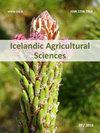Avian abundance and communities in areas revegetated with exotic versus native plant species
IF 0.2
4区 农林科学
Q4 AGRICULTURE, MULTIDISCIPLINARY
引用次数: 8
Abstract
Degradation of ecosystems and introductions of invasive species pose a threat to global biodiversity. Ecosystem restoration and revegetation actions are important for amending habitat loss and for the protection of species of plants and animals. Iceland has the highest rate of soil erosion and desertification in Northern Europe and counteractions to erosion and revegetation measures have taken place for over a century. We studied the effect of revegetation on the density and composition of birds and invertebrate abundance in 26 survey areas comparing: a) unvegetated eroded areas, b) native heathlands restored on eroded land, and c) revegetation by the introduced and exotic Nootka lupin (Lupinus nootkatensis) on eroded land. Birds were counted on transects and invertebrates sampled with a sweep net. Both revegetation methods greatly increased the abundance of birds. The highest total numbers of invertebrates and birds were recorded on land revegetated with Nootka lupin. On average 31 birds km -2 were recorded on barren land, 337 on heathland and 627 in Nootka lupin. Bird species composition differed between the two revegetation methods. Restored heathland provided habitat for waders of internationally decreasing populations, whereas Nootka lupin stands harboured more common bird species. Golden Plover (Pluvialis apricaria) and Dunlin (Calidris alpina) were most common on restored heathland, while Snipe (Gallinago gallinago) and Meadow Pipit (Anthus pratensis) were most common in Nootka lupine. The abundance of birds was positively correlated with that of invertebrates. The abundance of different bird species differed by successional stage in each habitat. The study showed the generally positive effects of revegetation on animal biodiversity and also how different revegetation methods produce different trajectories of ecosystem development.外来与本地植物复植地区的鸟类丰度与群落
生态系统退化和入侵物种的引入对全球生物多样性构成威胁。生态系统恢复和植被恢复对改善生境丧失和保护动植物物种具有重要意义。冰岛是北欧土壤侵蚀和荒漠化率最高的国家,一个多世纪以来一直在采取对抗侵蚀和恢复植被的措施。研究了26个调查区植被恢复对鸟类密度、组成和无脊椎动物丰度的影响,比较了:(a)无植被侵蚀区,(b)原生石南荒地恢复,(c)引进和外来露平(Lupinus nootkatensis)对侵蚀地的恢复情况。鸟类是在横断面上计数的,无脊椎动物是用扫网取样的。这两种植被方式都大大增加了鸟类的丰度。无脊椎动物和鸟类的总数最高的记录是在重新造林的土地上。平均在荒地上记录到31只鸟,在荒地上记录到337只鸟,在荒地上记录到627只鸟。两种植被方式的鸟类种类组成存在差异。恢复后的石楠荒原为国际上数量减少的涉禽提供了栖息地,而努特卡罗苹林则栖息着更多常见的鸟类。在恢复的石楠荒原上最常见的是金鸻(Pluvialis apricaria)和杜林(Calidris alpina),而在野地上最常见的是鹬(Gallinago Gallinago)和草甸Pipit (Anthus pratensis)。鸟类的丰度与无脊椎动物的丰度呈正相关。不同演替阶段不同鸟类的丰度不同。研究表明,植被恢复对动物生物多样性的总体积极影响,以及不同的植被恢复方式对生态系统发展轨迹的影响。
本文章由计算机程序翻译,如有差异,请以英文原文为准。
求助全文
约1分钟内获得全文
求助全文
来源期刊

Icelandic Agricultural Sciences
AGRICULTURE, MULTIDISCIPLINARY-
CiteScore
0.80
自引率
0.00%
发文量
0
审稿时长
>12 weeks
期刊介绍:
Icelandic Agricultural Sciences is published annually, or more frequently. The deadline for submitting manuscripts that are intended to appear within that year is September. The journal is in English and is refereed and distributed internationally. It publishes original articles and reviews written by researchers throughout the world on any aspect of applied life sciences that are relevant under boreal, alpine, arctic or subarctic conditions. Relevant subjects include e.g. any kind of environmental research, farming, breeding and diseases of plants and animals, hunting and fisheries, food science, forestry, soil conservation, ecology of managed and natural ecosystems, geothermal ecology, etc.
 求助内容:
求助内容: 应助结果提醒方式:
应助结果提醒方式:


